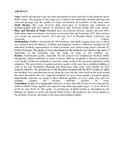| dc.contributor.author | Onyancha, Caroline | |
| dc.contributor.author | Nyamai, Christopher | |
| dc.date.accessioned | 2014-07-07T07:54:45Z | |
| dc.date.available | 2014-07-07T07:54:45Z | |
| dc.date.issued | 2014 | |
| dc.identifier.citation | British Journal of Applied Science & Technology, 4 (25) | en_US |
| dc.identifier.issn | ISSN: 2231-0843 | |
| dc.identifier.uri | http://www.sciencedomain.org/abstract.php? | |
| dc.identifier.uri | http://hdl.handle.net/11295/72139 | |
| dc.description.abstract | Aims: Saline and brackish water has been encountered in more than half of the boreholes across Kilifi County. The purpose of this study was to analyze the relationship between lithology and structural geology and the quality of water encountered in boreholes in the study area.
Study Design: The study involved field observation of boreholes and collection of hydrogeological data and analysis of geological and structural setting and water quality.
Place and Duration of Study: Borehole data was collected between January and June 2012. Field observation of boreholes was carried out between June and September 2012. Data analysis was carried out between October 2012 and July 2013 at Masinde Muliro University and University of Nairobi.
Methodology: Drillhole information for 180 boreholes with depths ranging from 6 m to 300 m was obtained from the Ministry of Water and Irrigation Archives. Subsurface profiles for the individual boreholes representative of various locations were plotted using Strater software (by Golden Software). The quality of water encountered in the boreholes was related to the mode of deposition of the sediments and the faults or folds at the borehole site.
Results: Groundwater quality, especially the salt content was compared in borehole drilled through the various formations at distant locations. With the exception of Mazeras sandstones, water quality in Duruma sediments is generally saline owing to the lacustrine deposition of the sediments. The great depths of aquifers and poor quality of the water have prohibited drilling of wells to the Taru Formation. Magarini and Pleistocene sands yield water suitable for most domestic purposes. The groundwater in the Mtomkuu formation and the Reef Complex is saline and brackish. Sea water intrusion occurs along the coast and the water levels in the wells remain the same throughout the year. Adjacent boreholes in areas where aquifers juxtapose against impermeable materials are found to have different qualities of water while slow and fast pumping regimes too produce different qualities of water.
Conclusion: In spite of a topographic difference of more than 200 m between the coast and the inland of Kilifi County, aquifers are expected at the following depth ranges: 11-22 m; 30-34 m, 45-50 m, and; 70-84 m. The quality of groundwater in Kilifi County is determined by the lithology in which it is stored and through which it flows, the position of the well in relation to the geologic structures, proximity to the ocean and pumping regimes. - See more at: http://www.sciencedomain.org/abstract.php?iid=588&id=5&aid=5180#.U7pOgECKE3w | en_US |
| dc.language.iso | en | en_US |
| dc.publisher | University of Nairobi | en_US |
| dc.title | Lithology and Geological Structures as Controls in the Quality of Groundwater in Kilifi County, Kenya | en_US |
| dc.type | Article | en_US |
| dc.type.material | en_US | en_US |


